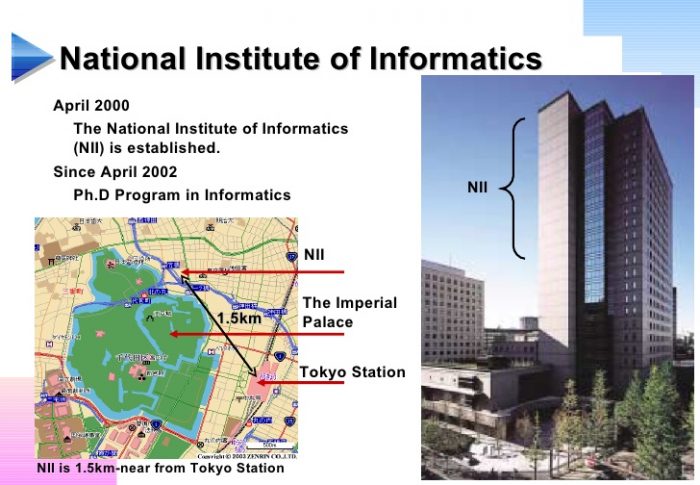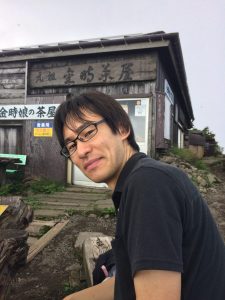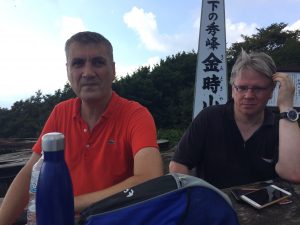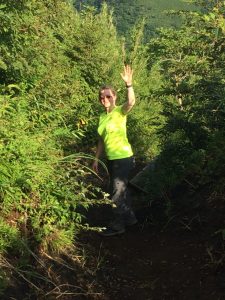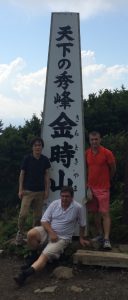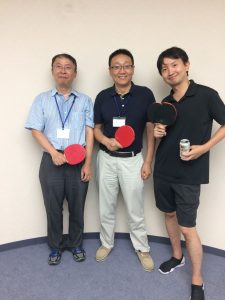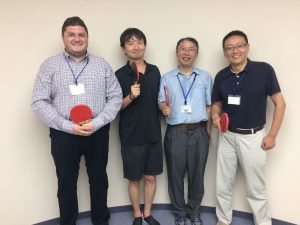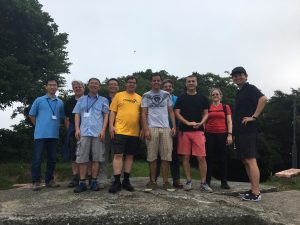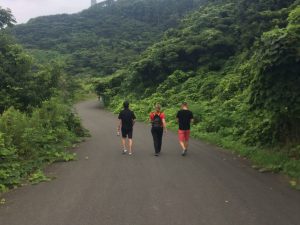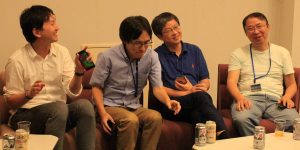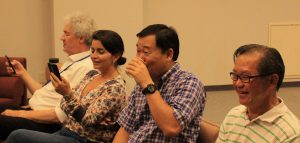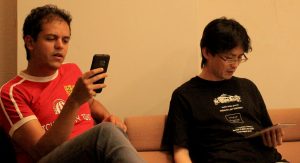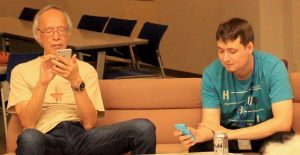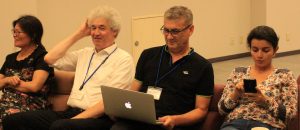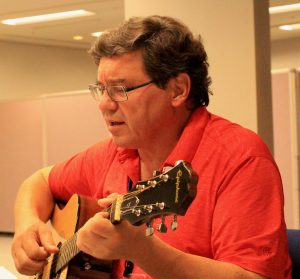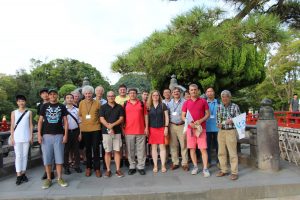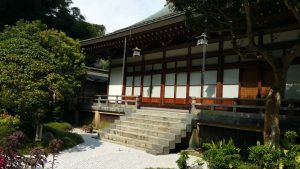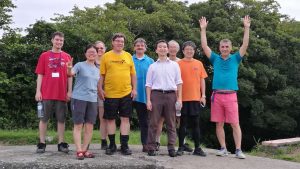SENCPS Presentation Abstracts
The Rise of Smart Cyber Physical Systems
Hausi A. Müller, University of Victoria, Canada
https://scholar.google.com/citations?user=8hyNFkYAAAAJ
Abstract: Cyber physical systems (CPS) are distributed, software-intensive systems that control tightly integrated and networked computational and physical components. CPS technologies are becoming the key enablers for how we control and build smarter, context-aware and situation-aware systems, such as autonomous vehicles, smart cities and buildings, renewable energy systems, elderly healthcare, resource management, and food supply chains. The societal impact of CPS and its associated industrial revolution is enormous. Advances in the interconnected capabilities of CPS affect virtually every engineered system. The technologies emerging from combining the cyber and physical worlds will provide an innovation and incubation engine for a broad range of industries—creating entirely new markets and platforms for years to come. CPS are advanced technology systems that require knowledge and training for their development and operation. A skilled workforce to support future CPS is a challenge and of strategic importance.
There are many challenges that must be addressed to be able to harvest CPS’s rich economic opportunities. In this talk, we will discuss selected CPS foundations and argue how the convergence of technologies affords transformative opportunities and applications. A CPS modifies its own behavior at runtime in response to changes within the system or its physical environment through feedback loops. The fulfilment of CPS requirements must be guaranteed even in the presence of adaptations. Traditionally, confidence in the correctness of a system is gained through analyses performed at design time. In the case of CPS, some assurance tasks must be performed at runtime. This calls for methods and techniques that enable continuous CPS assurance throughout its life cycle using models at runtime (MART). We will also discuss how to train scientists and engineers to succeed in this highly interdisciplinary field of CPS.
Hausi Müller is a professor of Computer Science and associate dean of research, Faculty of Engineering, at the University of Victoria, British Columbia, Canada. He is in his second term as VP of the IEEE CS Technical and Conferences Activities (T&C) Board (2016–2017), is an elected member of the CS Board of Governors (2015–2017), and was chair of the CS Technical Council on Software Engineering (TCSE). Müller is co-founder of the SEAMS conference series (ACM/IEEE International Symposium on Software Engineering for Adaptive and Self-Managing Systems). He was general chair of the 23rd ACM/IEEE International Conference of Software Engineering (ICSE 2001) and 30th IEEE International Conference on Software Maintenance and Evolution (ICSME 2014), and was recently technical program co-chair of IEEE World Forum on Internet of Things (WF-IoT 2015 and 2018). He is a Fellow of the Canadian Academy of Engineering and a CS Golden Core member, and received the 2016 TCSE Distinguished Service Award. He is an international expert in software engineering, software evolution, cyber-physical systems, adaptive systems, smart and context-aware systems, and program understanding. With his students, he collaborates extensively with industry. Müller received his BS in electrical engineering from ETH Zürich, Switzerland, and MS and PhD degrees in computer science from Rice University in Houston, Texas.
Engineering Abstraction/Refinement in Modelling and Verification of CPS
Fuyuki Ishikawa, National Institute of Informatics, Japan
https://scholar.google.ca/citations?user=v6stGAoAAAAJ&hl=en
Abstract. To tackle the intrinsic complexity of CPS, abstraction is the key in modelling and verification. Our approach uses a stepwise refinement process that considers multiple steps with different abstraction levels, where various concepts and constraints are gradually introduced and discussed.
In this talk, we argue how the design of the refinement steps affects the quality of modelling and verification activities and how we explicitly engineer the refinement steps. Specifically, we present our experience in “refinement refactoring” to support improvement of verifiability and reusability in multi-step models. We also discuss an orthogonal direction about “heteronization” of such methods originally for binary models into methods for quantified models (e.g., probabilistic or continuous).
Fuyuki Ishikawa is an associate professor at Digital Content and Media Sciences Research Division, National Institute of Informatics, Japan. His research interests include trust-worthy cyber physical systems, smart sensing, service compositions, adaptive systems, and service selection. He was a Visiting Associate Professor in the Graduate School of Information Systems at University of Electro-Communications and Department of Informatics, School of Multidisciplinary Sciences, The Graduate University for Advanced Studies at Sokendai University. In 2007, he received is PhD in Information Science and Technology from the University of Tokyo.
Control Theory Models for Cyber-Physical Systems
Marin Litoiu, York University, Canada
https://scholar.google.ca/citations?user=FWASYv0AAAAJ&hl=en
Abstract. Cyber-physical systems must have a degree of autonomy to cope with changes in the environment, faults, cyber-attacks, etc. This autonomy applies to both the physical and software components. These components have to monitor their own behavior and autonomously make dynamic adjustments to maintain desired properties in response to changes in the systems’ operational contexts. Control theory provides feedback models and controllers to realize this kind of autonomy for a broad class of physical systems. In software, recent MAPE-K models address a broader range of autonomic tasks. However, they do not provide the inherent assurance mechanisms that control theory does, as they do not explicitly model the properties that reliable systems should have.
In this presentation, we focus on the software component of cyber physical systems and show that, even for systems too complex for direct application of classical control theory, the abstractions of control theory provide design guidance that identifies important control characteristics and raises critical design issues about the details of the strategy that determine the controllability of the resulting systems. We examine the control theory approach, explain several control strategies illustrated with examples from both domains, classical control theory and software, and discuss challenges for developing principles that may serve as the basis of a control theory for designing cyber physical systems. Details of the presentations are presented in [1].
[1] Marin Litoiu, Mary Shaw, Gabriel Tamura, Norha M Villegas, Hausi Müller, Holger Giese, Eric Rutten, Romain Rouvoy, “What Can Control Theory Teach Us About Assurances in Self-Adaptive Software Systems?” in R. de Lemos; D. Garlan; C. Ghezzi; H. Giese. Software Engineering for Self-Adaptive Systems 3: Assurances, Springer, 2017, http://www.yorku.ca/mlitoiu/papers/WhatCanControlTeachUs.pdf
Marin Litoiu is an associate professor at York University, Toronto, Canada. His research interests are in the area of modeling and design of autonomic and self-adaptive systems running on shared infrastructures. His team won the 2010 IBM CAS Research Project of the Year Award. In 2011, Dr. Litoiu received the IBM CAS Faculty Fellow of the Year Award for his “impact on IBM people, processes and technology.” Prior to joining York University, he was a Research Staff member with the IBM Toronto Lab where he led research programs in software engineering and autonomic computing. Dr. Litoiu was Chair of the SEAMS Steering Committee and was General Chair of SEAMS 2013.
Live Blackboxes: Requirements for Tracking and Verifying Aircraft in Motion
Yijun Yu, The Open University, UK
https://scholar.google.com/citations?user=E5Z63aUAAAAJ&hl=en
Abstract. The Malaysian Airlines (MH370) aircraft went missing somewhere over the Indian Ocean three years ago. After intensive search since then, international team still has not been able to locate any first-hand evidence from the missing plane’s flight data recorders (also known as `blackboxes’). To mitigate similar problems, a proposal has been made to analyse live streamed flight data using cloud computing; however, satellite communication is constrained by bandwidth and scalability challenges. In this talk, I propose five requirements for addressing these challenges. These requirements frame a class of monitoring problems that share some similar accuracy concerns around safety and security. We evaluate these requirements to assess the readiness of the proposed technology – which we call “live blackboxes” — by using actual global scale data and performing an analysis of different live streaming intervals. Preprocessing with a locality-sensitive hashing function, it results in reduction of the required bandwidth by 5 times. Therefore, to track and verify all civilian aircraft in motion, the scalability requirement could be satisfied by satellite communications. While the paper focuses on a particular problem in air traffic management, I speculate similar requirements for the continuous monitoring the probabilistic behaviour of critical cyber physical systems, if we can network them together through innovative technology.
Yijun Yu is a Senior Lecturer in Computing at The Open University, UK. He is interested in developing automated, efficient and scalable software techniques and tools to better support human activities in software engineering. He has a vision to improve aviation security through cloud computing and blockchains by live streaming blackboxes after the missing MH370 flight, which featured in interviews with BBC Radio 4 and BBC World Services aired in April 2014, and receives Microsoft Azure Award (2017). His research on requirements-driven adaptation receives a 10 Year Most Influential Paper award (CASCON’16), Best Paper awards (iRENIC’16, IEEE TrustCom’14, ACM EICS’13), Distinguished Paper awards (IEEE RE’11, BCS’08, ACM SigSoft ASE’07), and Best Tool Demo Paper (RE’13) award. He serves as an Associate Editor of the Software Quality Journal, Chair of BCS Specialist Group on Requirements Engineering, a PC member of international conferences on Software Engineering (FSE, ICSE), Requirements Engineering (RE, CAiSE), Software Maintenance and Evolution (ICSME, CSMR, SANER, ICPC), Security (ESSoS), and World Forum on Internet of Things (WF-IoT). He managed several knowledge transfer projects with Huawei, IBM, CA, RealTelekom, and is a co-investigator on research projects including Adaptive Security and Privacy (ERC Adv. Grant, 2012-2018), and Adaptive Information Systems (QNRF, 2012-2016), Lifelong Security Engineering for Evolving Systems (EU FP7, 2009-2012), and Usable Privacy for Mobile Apps (Microsoft SEIF, 2012).
Conversational Agent Foodie Fooderson
Ulrike Stege, University of Victoria, Canada
https://scholar.google.ca/citations?user=1Zp5jw8AAAAJ&hl=en
Abstract. Conversational agents can allow interaction with technology when traditional methods are unavailable, unsafe or inconvenient, and may reduce the effort to complete a task using reasoning capabilities and by exploiting context. Smart speakers and smart phones allow hands-free access to digital assistants (such as Alexa, Cortana, Google Assistant and Siri). However, so far, each of these assistants only excels in particular areas, such as the operation of smart home devices, current weather conditions or sports results. Many other requests often end up in a general web search that the assistant executes for you.
In this talk we will discuss the use and benefits of specialized conversational agents and their role in everyday cyber physical systems. Our agent Foodie Fooderson is a text and voice supported kitchen assistant built using IBM Watson technology that can assist families in improving eating habits through, e.g., recipe recommendations that take into account personalized context, such as medical history, food allergies and dietary goals. Foodie can also support other goals, such as the family’s efforts to reduce food waste and optimize grocery budgets. We will describe Foodie and its architecture: Foodie uses IBM Watson’s conversational services to recognize users’ intent and understand events related to the users and their context, services from CAPRecipes, a Context-Aware Personalised Recipe Recommender, SmarterContext—a personal context management system, and selected publicly available nutrition databases.
Ulrike Stege is an Associate Professor in the Department of Computer Science, University of Victoria, Canada, where she serves currently as Department Chair. She did her doctorate at ETH Zürich in 2000. Her research interests are interdisciplinary and include algorithms and complexity with special interest in parameterized complexity, the applications areas of cognitive psychology with special interest in human problem solving and cognitive functions, cyber physical systems and adaptive systems and their integration with human, and computational biology.
Dynamic Deployment Challenges in the Context of Cyber-Physical Systems
Gabriel Tamura, Norha M. Villegas, Icesi, Colombia and Miguel Jiménez, University of Victoria, Canada
https://scholar.google.com/citations?user=xYQmIT8AAAAJ&hl=en
https://scholar.google.ca/citations?user=xdDVhAgAAAAJ&hl=en
Abstract. Cyber physical systems (CPS) can be viewed as software elements amalgamated with physical components comprising complex and distributed software-intensive systems, such as smart cities and buildings, and autonomous vehicles. Even though the engineering of CPS has achieved significant development, the deployment of this kind of systems pose challenges beyond the computing infrastructure as statically defined. However, CPS are also subject to change and evolve, and one way to realize global or partial behavioral change is by replacing the software elements of the physical components of the CPS. This replacement can be performed through software self-adaptation or reconfiguration, and is ultimately realized by dynamic deployment and configuration (D&C). Advances in job scheduling, storage orchestration, containerized applications, along with agile practices such as continuous integration and microservices architecture, have improved the state of the practice of D&C in software applications in general. However, little effort has been devoted to the need for D&C to support the various levels of detail and abstraction required by large-scale CPS. The understanding of the software components hierarchy has shifted from the comprehension of design artefacts, usually specified with static diagrams, to the understanding of runtime concepts. The DevOps movement has dramatically influenced how and when deployment is realized, but little has been done from the software perspective in terms of documentation and linkage between design and runtime CPS artefacts in the sense of software specification as such.
This talk presents an overview of the state of the art in D&C from our vision of deployment requirements for large-scale, distributed and complex CPS, and its automation. The D&C of such systems require technological capabilities that pose specific challenges in its specification. We characterize a set of deployment specification challenges intended as starting points for advancing the field of software deployment in CPS, namely: (1) the need for complete deployment notations to allow stakeholders specifying and visualising large-scale deployments from different perspectives and levels of abstraction. Current notations do not scale up well when working with large-scale systems, enforcing the creation of a bloated specification or many specifications containing duplicate elements. This is mainly because deployment specification tools are intended for producing static documentation, instead of managing the software as a dynamic entity where the configuration changes over time. (2) The need for deployment notations to support cross-cutting concerns. Different technical levels of stakeholder proficiency must be considered in the development of D&C specifications. D&C specification tools must provide high-level views of the application architecture and its deployment to executive stakeholders but also offer detailed technical views for specialized staff. (3) The need for notation and tool support for linking design and runtime deployment concepts. Software and its deployment specification evolve over time; however, systematic approaches to maintain the correspondence between diagrams and code are rarely used in practice. As the mapping between software and runtime deployment concepts becomes more complex, staff skills required to realise software deployment are higher. And (4) tool support for the evolution of deployment specifications and configuration management at runtime. Regardless of the mechanisms used to deploy and update software components, deployment specifications must mirror the system deployment as it adapts. What remains a challenge is how to depict the D&C evolution effectively. We strongly believe that the current research focus on the computing infrastructure is not enough for coping with these challenges. By identifying them, we aim to motivate researchers to investigate deployment specification in the context of large-scale CPS.
Gabriel Tamura is Associate Professor and leader of the Software Architecture and Engineering research line of the Department of ICT at Icesi University (Colombia). He has been scientific visitor at INRIA Lille Nord Europe research center, and obtained his Ph.D. in Software Engineering from University of Lille 1 (Lille, France) and University of Los Andes (Bogotá, Colombia), and holds a M.Sc. degree and a B.Eng. diploma, both in Systems Engineering and Computing. His current research interests include the engineering of context-driven self-adaptive software systems, the evolution of component-based and service-oriented computing, and the formalization of architecture-based mechanisms for self-adaptation.
Miguel Ángel Jiménez is currently a PhD student at the Department of Computer Science of the University of Victoria (Canada) and holds a M.Sc. degree in Information and Communication Technologies and a B.Eng. diploma in Systems Engineering from Icesi University (Colombia). His research interests include the specification and automation of software deployment, the design of self-adaptive software systems, and service-oriented and microservices software architecture.
Runtime Modelling for User-Centric Smart Cyber-Physical-Human Applications
Lorena Castañeda, University of Victoria, Canada and Norha M. Villegas, Icesi, Columbia
https://scholar.google.ca/citations?user=NDDpdC4AAAAJ&hl=en
https://scholar.google.ca/citations?user=xdDVhAgAAAAJ&hl=en
Abstract. Cyber-Physical-Human Systems (CPHSs) that assist users in the achievement of personal goals require runtime representations to understand the user’s context, personal goals and situations. Moreover, CPHSs require runtime adaptation capabilities to regulate their requirements satisfaction under unforeseeable changing situations, particularly those associated with the users. In this regard, for CPHSs to become user-centric and situation-aware, these systems need to be enabled to: (1) understand users, their personal goals and changing situations, (2) causally connect the cyber, physical and human components involved in the achievement of users’ personal goals, and (3) support runtime adaptation to respond to relevant changes in the users’ situations.
In this talk, we present our research on runtime models and runtime infrastructures to represent and support user-centric smart cyber-physical-human applications. Our research comprises (1) our characterization of user-centric smart cyber-physical-human applications, (2) our runtime models to represent dynamic users’ taskings and situations, (3) our framework to support runtime CRUD operations, and (4) our processing infrastructure for models at runtime to manage runtime CRUD operations requests.
Lorena Castañeda is a PhD Candidate in the Department of Computer Science at the University of Victoria, Canada. She holds a double degree in Engineering: Computer Engineer and Telecommunications Engineer in 2007, and a Master in Information and Communications Management in 2012 from Icesi University, Colombia. Her research interests focus on smart applications, self-adaptive situation- and context-aware systems, and runtime models.
Developping Cyber-Physical Systems from
Feature Clouds and Learned Behavioral Interactions
Nicolás Cardozo, Universidad de los Andes, Colombia
https://scholar.google.com/citations?user=3iTzjQsAAAAJ&hl=en
Abstract. Cyber-Physical Systems (CPSs) consist of physical objects found in the world that interact between each other and users by means of software systems and services, through sensors and actuators. The principle behind CPSs is easily accessible, however, in practice the interaction between objects is problematic. This problem arises due to the inherent distribution of the physical objects (and their associated services), both in time and location. Physical objects are not required to be aware of each other. At first sight this seems harmless, however, its consequence is that existing objects cannot seamlessly interact with newly introduced objects. Moreover, for newly introduced objects to interact with existing objects, they will have to explicitly know them beforehand, which may be unfeasible due to the distributed characteristic of CPSs. This makes the realization of true CPSs complicated, if not unfeasible. Object provided services must evidence three characteristics to enable seamless composition between them, and strive for true CPSs: (1) Objects need to adapt to their execution context (e.g., to account for the introduction of new objects). This enables interaction between different objects of a known type (e.g., incorporating new services, or exchanging two services if one fails). (2) Moreover, communication between objects should be organic, so that interactions between objects can be discovered rather than rigidly predefined by developers. (3) Finally, services associated to objects should be custom for every user. Enabling the possibility to learn the specific service behavior from it’s previous uses is key to attain a high level of personalization for CPSs. This work approaches the development of dynamically composable and adaptive CPSs from the perspective of programming languages, anchored in the Context-oriented Programming (COP) paradigm used to foster dynamically adaptive software systems. Build on top of COP, we present introduce the concept of feature clouds and extend the model with learning techniques, in order to offer the desired characteristics of CPSs. The following provides an overview of the different advances to satisfy the aforementioned requirements. CPSs as Clouds of Fine-grained Behavior CPSs are composed of multiple physical objects and the services they provide. Such objects can be provided by different manufacturers, making their interoperability difficult. Nonetheless, it is possible to think of CPSs as composition of services available in the environment, creating a feature cloud. Feature clouds are clusters of fine-grained behavior (delimited by a (network) environment) from which software systems can be build [4]. Feature clouds are based on COP to enable the dynamic composition of systems as adaptations of new features available in the environment. In this paradigm, users have access to available services in the environment (i.e., a feature cloud repository). Services can be manually selected for use, which triggers the composition of the given service, with that already in use by the user. As a consequence, services offered by physical objects can adapt at run time to use improved services (e.g., based on their Quality of Service (QoS) attributes), or extend the behavior of the existing services, with new capabilities available in the environment. Service Emergence from New Interactions Using the feature clouds model for the interaction and seamless incorporation of new objects and their associated services to existing CPSs enables the adaptation of the system to its execution context. However, such adaptation is restricted to predefined interactions of the existing services. Deviating from existing services to account for new services associated with newly introduced objects is not possible. To enable a flexible interaction between services in the environment it is necessary to incorporate a discovery mechanism within each object. This mechanism entails message exchanges between services to assess their relevance and compatibility (typically using QoS attributes associated with each service and their required inputs and provided outputs) [5]. Services for which interaction is possible (i.e., their inputs and outputs match) learn such interaction and can be composed, effectively offering a new service that may have not been foreseen by developers [1]. Such emergent services can then be pushed to the feature cloud repository to be selected by users. Moreover, the objects and their associated services should be personalized to the different users. Customizing the services for each individual user beforehand is unfeasible. However, it is possible to take advantage of the mechanism already in place for the emergence of new services, to learn user interactions with different objects and services. Such a learning process continuously enables the generation of COP-style adaptations from (ever-changing) userspecific preferences, effectively adapting the general behavior of services to specific users, and their execution environment [3, 2].
[1] Cardozo. “Emergent Software Services”. In: In Proceedings of the ACM International Symposium on New Ideas and Reflections on Software. Onward!’16. ACM, 2016, pp. 15–28.
[2] Cardozo and I. Dusparic. “Learning Behavioral Adaptations from the Context”.
[3] Cardozo, I. Dusparic, and J. H. Castro. “Peace COrP: Learning to solve conflicts between contexts”. In: Proceedings of the Workshop on Context-Oriented Programming. COP’17. ACM, 2017, to appear.
[4] Cardozo, K. Mens, S. González, P.-Y. Orban, and W. De Meuter. “Features on Demand”. In: Proceedings of the 8th International Workshop on Variability Modelling of Software-intensive Systems. VaMoS’14 18. ACM, 2014, 18:1–18:8.
[5] Chen, N. Cardozo, and S. Clarke. “Self-Organizing Goal-Driven Services in Mobile Pervasive Computing”. In: Transactions on Services Computing 99 (2016), pp. 1–14.
Nicolás Cardozo is an assistant professor at the Universidad de los Andes in Bogotá, Colombia since 2016. His main research area is adaptive software systems, approaching their design and from the perspective of programming languages, working in the design and implementation of different Context-oriented Programming languages as the work of his PhD thesis at the Université catholique de Louvain and the Vrije Universiteit Brussel in Belgium, which he finished in 2013, continuing as a post-doc at the Vrije Universiteit Brussel. Between 2014 and 2016 Nicolás was a post-doc at Trinity College Dublin in Ireland, working in the are of Smart Cities, integrating adaptive software technologies with the development of smart city systems. Nicolás’ new research endeavors focus in reconciling Machine Learning and adaptive systems to raise the flexibility of interactions in highly modular and disaggregated systems.
Verifying and Validating Cyber-Physical Systems with Uncertain Environmental Interactions
Chang Xu, Nanjing University, China
https://scholar.google.ca/citations?user=jlZOlxIAAAAJ&hl=en
Abstract. Cyber-physical systems (CPS) are useful and important. They interact with complex environments, by sensing environmental changes, adapting their behavior, and taking actions to affect the environments and themselves. Unfortunately, the interactions can suffer from uncertain factors, leading to unreliable sensing and flawed adaptation. This could further cause unexpected system failure at runtime. This talk outlines our efforts on: (1) verifying CPS, with a robot-car application example, to obtain more accurate verification results by considering uncertain environmental interactions, and (2) validating the verification results more efficiently by constructing path-equivalent counterexamples for CPS.
Chang Xu received his Ph.D. degree from The Hong Kong University of Science and Technology (HKUST) in 2008. He worked as a research assistant professor with the Department of Computer Science and Engineering at HKUST from 2008 to 2010. In Sep 2010, he joined Nanjing University, as an associate and then full professor with the State Key Laboratory for Novel Software Technology and Department of Computer Science and Technology. His research interests include big data software engineering, software testing and analysis, and adaptive and embedded system. His work has been reported by publications at international journals and conferences, which include TOSEM, TSE, ESEC/FSE, ICSE and ASE. He received ACM SIGSOFT Distinguished Paper Award in ICSE 2014 and Best Paper Award in APSEC 2014. He organized MIDDLEWARE 2013 Doctoral Symposium, FSE 2014 SEES Symposium and COMPSAC 2017 SETA Symposium.
High-Assurance Software-Defined IoT Security
Grace Lewis, Carnegie Mellon Software Engineering Institute, USA
https://scholar.google.ca/citations?user=uwshWMoAAAAJ&hl=en
Abstract. Many organizations are reluctant to incorporate IoT devices into their systems due to increasing reports of exploited vulnerabilities in off-the-shelf IoT devices. We propose to create an IoT framework that operates, with high assurance, in a resilient and trustworthy manner even in the presence of a powerful and realistic attacker, who can compromise IoT devices, control nodes, and other intermediaries. To this end, we propose to develop a software-defined IoT infrastructure composed of (i) a high-assurance control node that monitors security-relevant events and alters the “security postures” of IoT devices to enforce specific policies; (ii) trusted data nodes that execute these security postures for each IoT device using “micro-middleboxes”; and (iii) firmware-hardened IoT device nodes, which can be untrusted (e.g., commodity), or trusted (e.g., custom-built by a trusted contractor) but have verifiably secure communication with the control node and data nodes. Elements within the infrastructure will be developed using the open-source überSpark framework for incrementally implementing and verifying properties in system-software stacks (e.g., hypervisors, firmware).
Grace Lewis is a Principal Researcher at the Software Engineering Institute (SEI) at Carnegie Mellon University (CMU), where she is the principal investigator for Tactical Cloudlets, Authentication and Authorization of IoT Devices in Edge Environments, and the upcoming High Assurance Software-Defined IoT Security research project. Her current interests and projects are in edge computing, cloud computing, IoT security, and software architecture. She has a B.Sc. in Software Systems Engineering and a Post-Graduate Specialization in Business Administration from Icesi University in Colombia; a Master in Software Engineering from Carnegie Mellon University; and a Ph.D. in Computer Science from Vrije Universiteit Amsterdam. She is Executive Vice Chair and a member-at-large of the IEEE Technical Council on Software Engineering (TCSE), as well as a member-at-large of the 2016 IEEE Computer Society Technical & Conference Activities Board (T&C) Executive Committee.
Smart Cyber Physical Systems:
Dealing with uncertainty through dynamic context management and self-adaptation
Norha M. Villegas, Icesi University, Colombia
https://scholar.google.com/citations?user=xdDVhAgAAAAJ&hl=en
Abstract. In Cyber Physical Systems (CPSs), multiple systems interact to each other and their physical environment, including humans, to accomplish functional requirements while assuring desired quality properties. In the CPSs realm, context information can be defined as all variables measured from the cyber and the physical environment, and that are relevant for defining and assuring the expected behavior of the CPS. Nevertheless, the CPS only has partial knowledge of its environment. This is in part because context information that defines the situation of environmental entities, particularly of humans, is highly dynamic. As a result, it is impossible to fully specify, from design time, context entities that are relevant for the system (the cyber) to interact with the physical world (including humans), and the way how the system must reply or anticipate to changes in these context entities. This demands the development of mechanisms that improve situation-awareness and self-adaptation in CPSs to operate reliably and safely under the presence of uncertainty.
Situation-awareness refers to the capability of a system to gather and process information from its environment to understand the situation of external and internal entities that can affect the system in the accomplishment of its goals. Under uncertain environments, for a CPS to effectively be situation-aware and smart, it must be enabled with dynamic context management mechanisms that allow it to understand changes in unforeseen context situations; and self-adaptation mechanisms that allow it to behave according to these changes. Dynamic context management implies preserving the relevance of monitoring strategies, under context monitoring requirements that change while the system is running. For this, smart CPSs must be engineered to: 1) automatically discover, at runtime, new context entities that may affect their behavior; 2) automatically infer a new monitoring strategy to keep track of new context entities; and 3) self-adapt to deploy new monitors and actuators.
In this talk, we will discuss challenges that CPSs must face due to uncertainty, and how dynamic context-management and self-adaptation can help in the engineering of smarter CPS able to assure their operation under uncertain situations.
Norha M. Villegas is an Assistant Professor in the Department of Information and Communication Technologies, Director of the Software Systems Engineering bachelor program at Universidad Icesi, Colombia, and an Associate Member at the Faculty of Graduate Studies at University of Victoria, in Canada. Her research interests include context-management, context-aware analytics, self-adaptive and self-managing systems, runtime software evolution, and more recently, cyber-physical systems. In general, she is interested in the application of dynamic context-management and self-adaptive software techniques to improve the dynamic and situation-aware capabilities of software systems. She obtained her PhD in software engineering from University of Victoria (Victoria, Canada).
Linguistic and Runtime Supports for Energy-aware Software Systems
Hidehiko Masuhara, Tokyo Institute of Technology, Japan
https://scholar.google.ca/citations?user=tq4dtkUAAAAJ&hl=en
Abstract. Software systems can be more energy-aware if we can switch implementations of internal modules with the ones having different performance characteristics. In order to develop such software systems, it is important to provide a module system so that the programmer can easily manage multiple implementations of a module, and to find a set of implementations for the target hardware platform that is suitable in terms of energy consumption as well as quality of service. We plan to develop a language mechanism where the programmer can describe multiple implementations by using layers in context-oriented programming, and a runtime system dynamically choose a combination of implementations by using a sampling-based online algorithm. This is a joint work with Anthony Canino and David Liu at SUNY Binghamton, USA
Hidehiko Masuhara is a Professor at Department of Mathematical and Computing Sciences, Tokyo Institute of Technology. He received his B.S., M.S., and Ph.D. degrees from the University of Tokyo in 1992, 1994 and 1999 respectively. Before joining Tokyo Institute of Technology, he served as an Assistant Professor, Lecturer, and Associate Professor at Graduate School of Arts and Sciences, the University of Tokyo. His research interests include design and implementation of programming languages and software development environments.
Toward Model-Based Environment Perception for Self-Adaptive Software Systems
Xiaoxing Ma, Nanjing University, China
https://scholar.google.com/citations?user=44WpWR4AAAAJ&hl=en
Abstract. Effective and efficient perception of the environment in which a software system is situated is crucial for the self-adaptation of the system. However, software engineering so far is mainly focused on building machines exhibiting desired behavior, but not machines recognizing and predicting environmental behavior. Based on a metaphor of epistemology, we propose a preliminary software perception framework that takes environment meta-models and specifications as a priori knowledge and derives at runtime a posteriori model instances for event detection and prediction. We also show how this framework applies to the perception of complex events in distributed environment. This talk is to provoke a discussion about the challenges of disciplined software engineering, especially specification and modeling, for environment perception.
Xiaoxing Ma is a professor in the Department of Computer Science and Technology, and the deputy director of the Institute of Computer Software, Nanjing University, China. He received his PhD degree from the same University in 2003. His research interests include self-adaptive software systems, software architectures and middleware systems. He co-authored more than 60 peer-reviewed papers, some of which were published in major software engineering conferences and journals such as FSE/ICSE/ASE and IEEE TSE/TC/TPDS. He has directed and participated over a dozen research and development projects funded by national level agencies, and won two National Science and Technology Progress Awards in 2006 and 2011, respectively.
DevOps and BizOps for IoT: From Development to Management and Commercialization
Marios-Eleftherios Fokaefs, Polytechnique Montréal, Canada
https://scholar.google.com/citations?user=CFKjCQQAAAAJ&hl=en
Abstract. The proliferation of interconnected devices and instrumented “things”, including cars, buildings and civil infrastructure, along with advancements in connectivity and data flow, have led to the emergence and eventual ubiquity of the “Internet-of-Things”. Despite its popularity, and the prior existence of more targeted and specific efforts, especially in the automotive and aerospace industries, there is a significant lack of general standardization in the IoT domain. From a software engineering perspective, the discussion on standardization revolves mainly around end-to-end development processes and quality assurance, especially concerning performance and security, which are of paramount importance. DevOps is an emerging culture that represents this need for standardization and advocates the integration between development and QA, and IT management in general. The core challenges for IoT systems are what DevOps tools are needed for such heterogeneous systems with many and possibly conflicting goals and how these tools abstract the desired integration to increase the efficiency of developers. Besides their technological emergence, IoT systems and their related services have also seen an increased popularity as products and digital business. Again, due to their intrinsic heterogeneity and general applicability, IoT systems pose novel and interesting challenges concerning their business side; how do we estimate and predict cost for IoT systems? How do we determine the value of IoT services? How do we price complete IoT solutions? The answers to these questions will eventually be consumed by BizOps, the team responsible for the business side of the software product. In this presentation, I will outline the aforementioned challenges with a greater goal in mind; the integration of DevOps with BizOps in the context of IoT software systems.
Marios Fokaefs is an Assistant Professor with the Department of Computer and Software Engineering at Polytechnique Montréal. Previously, he was a postdoctoral fellow with the Adaptive Software Research Lab in the Department of Electrical Engineering and Computer Science, York University. He holds BSc in Applied Informatics from the University of Macedonia, Greece, a MSc and a PhD in Software Engineering from the Department of Computing Science, University of Alberta, Canada. His research revolves around the problems of software evolution and change management in the context of DevOps with particular focus on service, cloud and IoT systems. Additionally, his research looks into the relationship of technical decisions with economic considerations in software systems. Marios Fokaefs is an IEEE Member and former IBM Student Fellow, while he has also served in the program committees of IEEE ICSME, IEEE ICWS, IEEE CLOUD, IEEE MESOCA, IEEE ICSOC and CASCON among others. His research has been supported and funded by IBM, FuseForward Solutions, AITF from Alberta, ORF, OCE and SOSCIP from Ontario, as well as the Natural Sciences and Engineering Research Council of Canada.
Cyber-Human Partnerships — Towards a resilient ecosystem in Smart Cities
Schahram Dustdar, Technical University of Vienna, Austria
https://scholar.google.com/citations?user=0n5S6uUAAAAJ&hl=en
Abstract. In this talk I will explore one of the most relevant challenges for a decade to come: How to integrate the Internet of Things with software, people, and processes, considering modern Cloud Computing and the Internet of Things (IoT) with Big Data. I will present a fresh look at this problem, and examine how to integrate people, software services, and things with their data, into one novel resilient ecosystem, which can be modeled, programmed, and deployed on a large scale in an elastic way. This novel paradigm has major consequences on how we view, build, design, and deploy ultra-large scale distributed systems and establishes a novel foundation for an “architecture of value” driven Smart City.
Schahram Dustdar is Full Professor of Computer Science (Informatics) with a focus on Internet Technologies heading the Distributed Systems Group at the TU Wien. He is Chairman of the Informatics Section of the Academia Europaea (since December 9, 2016). He is elevated to IEEE Fellow (since January 2016). From 2004-2010 he was Honorary Professor of Information Systems at the Department of Computing Science at the University of Groningen (RuG), The Netherlands. He is a member of the IEEE Conference Activities Committee (CAC) (since 2016), of the Section Committee of Informatics of the Academia Europaea (since 2015), a member of the Academia Europaea: The Academy of Europe, Informatics Section (since 2013). He is recipient of the ACM Distinguished Scientist award (2009) and the IBM Faculty Award (2012). He is an Associate Editor of IEEE Transactions on Services Computing, ACM Transactions on the Web, and ACM Transactions on Internet Technology and on the editorial board of IEEE Internet Computing. He is the Editor-in-Chief of Computing (an SCI-ranked journal of Springer).
Hybrid Adaptation Policies for Self-Adaptive Systems
Frank Trollmann, Technical University Berlin, Germany
http://www.dai-labor.de/team/frank.trollmann
Abstract. The rule-based, goal-based and utility-based action selection approaches from agent-based systems have been widely adopted as adaptation polices for self-adaptive systems. These policies are often not employed in a pure form but are mixed with each other, leading to hybrid adaptation polices. In this talk I want to discuss our current research with respect to categorizing and structuring the landscape of hybrid adaptation policies. In particular, I will discuss some of our examples involving cyber-physical systems and would like to find out which hybrid adaptation policies are used by other participants of the Shonan meeting.
Frank Trollman: I was born in 1986 in Berlin, Germany and, after a brief detour around Germany for about 18 years, I returned to Berlin to study informatics at TU Berlin. After finishing my diploma thesis on “Modelling Emergency Scenarios using Algebraic Higher Order Nets” under Prof. Hartmut Ehrig I continued to study self-adaptive systems at DAI-Labor at TU Berlin under Professor Albayrak. Due to my background I have always had a particular focus of the application of techniques from formal specification and graph transformation. This research led to my PhD with the title “Detecting Adaptation Conflicts at Run Time using Models@run.time” in 2015. Since then I have been fortunate enough to coordinate the research group on “Next Generation Services” at DAI-Labor, which focuses on the application of techniques from artificial intelligence and agent-based systems for self-adaptive systems. Throughout my work at DAI-Labor I have been involved in research projects in several different cyber physical system domains, among them are autonomous vehicles, smart home technology and energy systems. The topic I want to present in my talk is derived from the experiences of my research group in those projects.
Programming Derivatives: Towards Change-Oriented Programming
Zhenjiang Hu, National Institute of Informatics (NII), Japan
https://scholar.google.com/citations?user=MvGKdLoAAAAJ&hl=en
Abstract. Change is essential and expensive in software development. Although a significant amount of work has been done on software change, its status as a scientific discipline is still an open challenge. In this talk, I will show that it is possible to treat software change as a first-class citizen, and that we can program changes through direct coding of derivatives.
Zhenjiang Hu is a full professor of National Institute of Informatics (NII) in Japan. He received his BS and MS degrees from Shanghai Jiao Tong University in 1988 and 1991, respectively, and PhD degree from
University of Tokyo in 1996. He was a lecturer (1997–1999) and an associate professor (2000–2007) in University of Tokyo, before joining NII as a full professor in 2008. His main interest is in programming languages and software engineering in general, and functional programming and bidirectional transformation in particular. He is the academic committee chair of the NII Shonan Meetings, IFIP WG 2.1 member, and has been the steering committee members of ICFP, Haskell, APLAS, ICMT, and BX. He is also serving on the editorial board members of IEEE Transactions of Software Engineering, Science of Computer Programming, and Software and Systems Modeling.
Models@run.time for self-adaptive systems: A controller synthesis approach
Kenji Tei, National Institute of Informatics (NII), Japan
http://www.nii.ac.jp/en/faculty/architecture/TEI-Kenji/
Abstract. In many application domains, continuous operation is a desirable attribute for software-intensive systems. As the environment or system requirements change, so the system should change and adapt without stopping or unduly disturbing its operation. There is, therefore, a need for sound engineering techniques that can cope with dynamic change.
In this talk, I will show models@run.time-based approach for self-adaptive systems based on discrete controller synthesis. Models are hold and used event at runtime for analysis and reasoning about software system to guarantee adaptations. I will overview architecture and key techniques about this approach.
Kenji Tei is an associate professor at National Institute of Informatics. Dr. Kenji Tei received Ph.D. in Engineering from Waseda University, Japan in 2008. He joined Department of Information and Computer Science in Waseda University, and National Institute of Informatics as a research assistant. From 2008 to 2010, he was assistant professor at Media Network Center in Waseda University, and project assistant professor at National Institute of Informatics. From 2010 to 2015, he was an assistant professor at National Institute of Informatics. He is interested in software engineering for self-adaptive software, in particular, models@runtime techniques and software architecture for self-adaptive software.
Quality Requirements Analysis for Smart Cyber Physical Systems with Machine Learning
Tetsuo Tamai, Hosei University, Japan
http://tamai-lab.ws.hosei.ac.jp
Abstract. Requirements engineering for smart cyber physical systems (CPS) is sophisticated, because a number of various aspects are related with CPS’s. Particularly, specifying non-functional or quality requirements is crucial as a CPS may encounter with risks that are hard to foresee.
We have developed an approach to classify requirements between functional and non-functional and further classify non-functional/quality requirements into quality categories. It is based on machine learning techniques and has been tried on publicly available 13 requirements specifications. Some technical points will be explained and the prospect of applying the proposed technology to CPS’s will be discussed.
Tetsuo Tamai received the B.S., M.S. and Dr.S. degrees in mathematical engineering from the University of Tokyo. He joined Mitsubishi Research Institute, Inc. in 1972, became Associate Professor of the University of Tsukuba in 1989, and then Professor of Graduate School of Arts and Sciences, the University of Tokyo in 1994. He retired from the University of Tokyo in 2012 and currently is Professor at Hosei University. His current research includes requirements engineering, high reliability component-based software engineering, collaboration and role modelling, formal analysis of software architectures and software evolution process.
What should matter in modeling Cyber-Physical Systems?
Haiyan Zhao, Peking University, China
https://scholar.google.com/citations?user=z0bu0kIAAAAJ&hl=en
Abstract. The Cyber-physical systems where cyber components interact extensively with physical world components through Internet and/or sensing networks have emerged. To successfully integrate computational and physical components seamlessly will require a thorough understanding of the multi-scale and multi-physics components, which is just the responsibility of modeling. However, there still is lack of unified modeling techniques at the right level abstraction for coping with complexity and scale of cyber-physical systems. In this talk, I’d like to share and exchange our point of view on modeling cyber-physical systems.
Haiyan Zhao is associate professor in the Department of Computer Science and technology, School of EECS, Peking University, China, and a visiting professor in National Institute of Informatics, Japan. She obtained her B.Sc. and M.Sc. from Peking University, China, and Ph.D. from the University of Tokyo, Japan. Her research interests include requirements engineering and software product line in general, and requirements reuse and adaptation, and model-based software development, modeling techniques in particular.
Goal-oriented modeling and traceability recovery for IoT Ecosystems
Hironori Washizaki, Waseda University, Japan
https://scholar.google.com/citations?user=WE5V6bkAAAAJ&hl=en
Abstract. Traceability from goals and values to code and element is the key to address high productivity, reliability and maintainability in IoT Ecosystems development and evolution. In this talk, I will introduce a goal-oriented modeling for ensuring traceability in top-down manner, and a traceability recovery technique for ensuring traceability in bottom-up manner. Finally, I will discuss how these approaches contribute to IoT Ecosystems.
Hironori Washizaki is head and professor at Global Software Engineering Laboratory, Waseda University, Japan. He also works at National Institute of Informatics as visiting professor, and at SYSTEM INFORMATION CO. LTD. as outside director. He was a visiting professor at Ecole Polytechnique de Montreal in 2015. His research interests include software modeling, product line, and quality assurance. He is now vice-chair of IEEE CS Japan Chapter, chair of SEMAT Japan Chapter, director of IPSJ SamurAI Coding, Convenor of ISO/IEC/JTC1/SC7/WG20, CSEE&T 2017 PC Co-Chair, IEEE CS Membership at Large for the Professional and Educational Activities Board, and Int. J. of Agile and Extreme Software Development (IJAESD) Editor-in-Chief.
Not Just Your Average Publish/Subscribe: Evolving to Support a New Generation of Applications
Hans-Arno Jacobsen, University of Toronto, Canada
http://www.eecg.toronto.edu/~jacobsen/
Abstract. The publish/subscribe paradigm has been integral in supporting a variety of distributed applications. Its simple yet powerful decoupling and filtering capabilities shine in scenarios that require selective data dissemination from many data sources and many data sinks. However, there is an emerging class of applications that strain traditional publish/subscribe systems. For example, Internet of Things, social networks, and traffic management scenarios manage volumes of data that necessitate aggregating or selecting only the most relevant events. Similarly, complex business process logic demands increasingly expressive matching semantics. While these requirements can be implemented at the system edge, we claim that they are better addressed as capabilities offered by the publish/subscribe system.
In this talk, we present a number of novel techniques and extensions to the publish/subscribe paradigm, inspired by emerging use cases. This includes extensions to coordinate the execution of distributed business processes, techniques to aggregate across publication streams in support of traffic management and Internet of Things scenarios, and extensions to compute the top-k matching subscriptions prevalent for tuning in on the relevant information in social networking. Finally, we hint at how core publish/subscribe operations could be accelerated through emerging hardware opportunities to support their efficient implementation.
Hans-Arno Jacobsen is a professor of Computer Engineering and Computer Science and directs the activities of the Middleware Systems Research Group (http://msrg.org). He conducts research at the intersection of distributed systems and data management, with a particular focus on middleware abstractions, (complex) event processing, and cyber-physical systems. After studying and completing his Ph.D. in Germany, France, and the U.S., he engaged in post-doctoral research at INRIA near Paris, before moving to the University of Toronto in 2001. In 2011, he was awarded the Alexander von Humboldt-Professorship to engage in research at TUM in Germany on “Energy Informatics.”
Control-Theoretical Software Adaptation
Danny Weyns, Katholieke Universiteit Leuven, Belgium
https://scholar.google.ca/citations?user=MG8iJPAAAAAJ&hl=en
Control theory has been identified as a principled way to achieve goals of computing systems that operate under uncertainties. The main focus in this area so far has been on the adaptation of resources that the software has available for execution (servers, CPU, storage, etc.). To understand how control theory has been applied to realize adaptation of software, in particular application software and high-level middleware, we performed a systematic literature review. We extracted data from 42 primary studies. In this talk, I present some of the results of our investigation and from that distill a number of challenges for adaptation of software based on control theory.
Danny Weyns is a professor at the Department of Computer Science of the Katholieke Universiteit Leuven, Belgium. My main research interest is in engineering of self-adaptive software systems. With my PhD students, I study formalisms and design models to realize and assure self-adaptation for different quality goals. We apply both architecture-based and control-based approaches to realize self-adaptation. One of the domains that we use to validate our research results is the Internet of Things.
CPS Systems Delivery and Deployment Agility: Research Challenges and Issues
Kostas Kontogiannis, Western University, Canada
https://scholar.google.com/citations?user=gNZOUUAAAAAJ&hl=en
Abstract. The Internet of Things (IoT) emerges as a major architectural paradigm for achieving Machine to Machine (M2M) communication and realizing the Cyber-Physical systems (CPS). The fundamental principle behind IoT is the concept of a “resource” (or a “thing”), that serves as an abstraction of a basic unit that is interacting with its environment, and is capable of providing services, data and control elements to other internetworked resources. It is estimated that by 2025 there will be more than 75 billion internetworked IoT devices which will be fully connected and able to provide context-aware data acquisition, on-device processing, and local decision support and optimization, achieving what is known to as the IoT Universal Era.
This talk discusses research challenges pertaining to agility in the delivery and deployment of such systems which are highly adaptive and involve unpredictable and complex interactions between their cyber components and the physical world. This talk argues that in order to achieve such agility in environments requiring short and frequent release cycles, we need to address issues related to the specification of such IoT systems, investigate new IoT programming models, deal with active system management, and implement continuous component delivery and deployment through flexible DevOps pipelines.
Kostas Kontogiannis is a Professor at Computer Science Department at Western University, where he holds a Western Research Chair in Software Engineering for Cyber-Physical Systems. Prior to joining Western, Kostas served as a tenured faculty at the National Technical University of Athens and University of Waterloo. Kostas has received a BSc in Mathematics from the University of Patras, Greece, an MSc in Computer Science from Katholieke Universiteir Leuven, Belgium, and a PhD in Computer Science from McGill University, Canada. He is a Faculty Fellow at the IBM Center for Advanced Studies. Kostas is working in the areas of software analysis, service computing, and model driven engineering.


